Abstract
Aims and Objectives:
To determine the association between smoking, chewing tobacco (gutka), and age of individual on graying of hair.
Materials and Methods:
The present study was conducted on 120 patients attending the Outpatient Department of the DJ College of Dental Sciences and Research, Modinagar, UP. The individuals were classified into four groups (group I, II, III, IV) on the basis of the form of tobacco use (smoking or chewing). The Pearson correlation coefficient was utilized to find the correlation between the mean percentage of individuals with gray hair, risk multiplication factor (RMF), and age of the individual.
Results:
Mean percentage of individual with gray hair and RMF (r = 0.6487) are found to be positively associated. A significant and positive correlation was observed between the age of the individual and the frequency of individuals with gray hair.
Conclusion:
This study suggests that there is a significant association between tobacco use and aging on graying of hair.
KEYWORDS: Graying of hair, risk multiplication factor, smoking
INTRODUCTION
Skin and hair color contribute significantly to our overall visual appearance and to social/sexual communication.[1]
Hair graying (canities) is a natural age-associated feature. The rate at which an individual turns gray depends on genetics. Premature hair graying has also been associated with autoimmune disorders, as they occur in vitiligo (e.g. pernicious anemia, autoimmune thyroid disease) and several rare syndromes with premature aging (e.g. Werner's syndrome).[2]
There is also some evidence that age is associated with increased graying in humans.[3]
In addition, a link between smoking and gray hair in both men and women and between smoking and hair loss in men has been reported earlier.[4,5,6]
The mechanisms by which the use of tobacco causes hair graying are still unknown. The color of hair mainly relies on the presence or absence of the melanin pigment. Skin and hair melanins are formed in cytoplasmic organelles called melanosomes, produced by the melanocytes, and are the product of a complex biochemical pathway (melanogenesis), with tyrosinase being the rate-limiting enzyme. It has been seen that gray hair has undergone a marked reduction in melanogenically-active melanocytes in the hair follicle. The net effect of this reduction is that fewer melanosomes are incorporated into the cortical keratinocytes of the hair shaft. In addition, there also appears to be a defect of melanosome transfer, as the keratinocytes may not contain melanin, despite their proximity to the melanocytes with the remaining melanosomes.[7]
It has been indicated that smoking could be associated with generating huge amounts of reactive oxygen species leading to increased oxidative stress.[6]
This pro-oxidant effect of smoking could lead to damage in the melanin-producing cells-the melanocytes. This theory is supported by the observation that melanocytes in gray hair bulbs are frequently highly vacuolated, a common response to increased oxidative stress.[8]
The aim of the present study is to correlate smoking as well as chewing tobacco (gutka) with graying of hair in individuals.
MATERIALS AND METHODS
The study was conducted in the D.J. College of Dental Sciences and Research, Modinagar, UP. The study sample consisted of 120 individuals, attending the Outpatient Department of the DJ College of Dental Sciences and Research. Individuals who smoked four cigarettes/day since two years and individuals who chewed at least two packs of gutka/day since two years were included in the study sample. Most of the individuals were occasional drinkers, who consumed alcohol once a week. Written informed consent was obtained from all the study participants, after explaining the purpose and objective of the study.
The study sample was randomized into four groups, with 30 patients in each group:
Group I (individuals with a habit of smoking tobacco)
Group II (individuals with a habit of chewing tobacco)
Group III (individuals with a habit of smoking and chewing tobacco)
Group IV control group (individuals without any history of tobacco use).
An arbitrary unit was obtained using frequency/day multiplied by duration of years of tobacco usage called the Risk Multiplication Factor (RMF). A detailed history was taken of the use of hair colorants. Patients using hair colorants were excluded from the study.
Statistical analysis
Comparison of the mean percent of individuals with gray hair in different groups was made by using the Unpaired ‘t’ test, using the statistics package SPSS 10. A P value of 0.05 or less was considered for statistical significance. The Karl-Pearson correlation coefficient was used to compare the age, RMF, and mean percent of individuals with gray hair in different groups.
RESULTS
The present study was carried out to assess the effect of tobacco on the graying of hair in patients with a habit of smoking tobacco (beedi or cigarette), chewing tobacco (gutka), smoking and chewing tobacco, and in those not using tobacco in any form.
All the values of age, risk multiplication factor, and mean percent of individuals with gray hair (smokers, chewers, smokers + chewers, and control group) are expressed as Mean and SD, respectively [Table 1]. The unpaired “t” test revealed a significant difference in the mean percent of individuals with gray hair between different pairs of groups in Table 2. However, the Karl-Pearson correlation coefficient revealed a positive and significant correlation between RMF and the mean percent of individuals with gray hair in each experimental group (0.6481 in smokers, 0.8314 in chewers, and 0.9455 in smokers + chewers) [Tables 3-5]. The mean age of individuals in each group was found to be 48.16 years in smokers, 33.56 years in chewers, 33.33 in (smokers + chewers), and 34.9 years in the control group [Graph 1]. Furthermore, it was observed that a positive and significant correlation was present between age and mean percent individuals with graying of hair in smokers, chewers, and smokers + chewers, respectively [Tables 3-5]. In the control group, correlation between age and mean percent in individuals with graying of hair was weak, positive, and non-significant at a 5% level of significance [Table 6].
Table 1.
Mean percentage of individuals with gray hair in the different groups
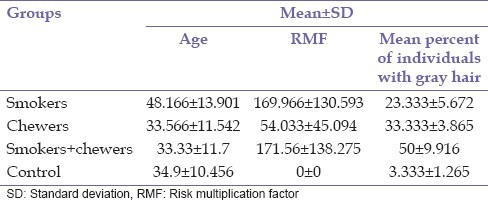
Table 2.
Comparison of mean percent of individuals with gray hair between different groups
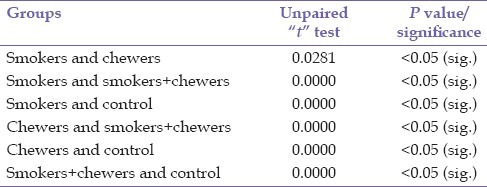
Table 3.
Correlation of Age, RMF, and mean percentage of individuals with graying in smokers

Table 5.
Correlation of age, RMF, and percentage of individuals with graying in (smokers+chewers)
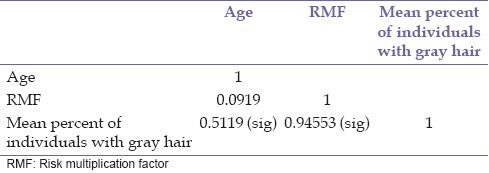
Graph 1.
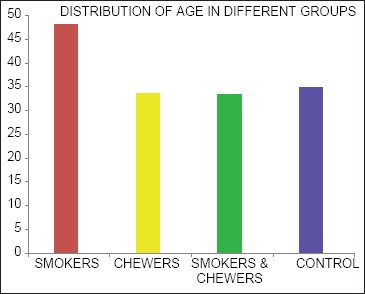
Age distribution in different groups
Table 6.
Correlation between age and percentage of individuals with graying in the control group

Table 4.
Correlation of Age, RMF, and percentage of individuals with graying in chewers
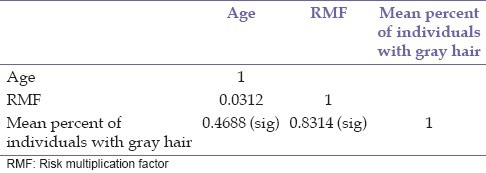
DISCUSSION
Aging is a complex process that affects all of us. All organs undergo a series of age-related changes, in which the vascular system is prominent.[4] Aging involves various genetic, hormonal, and environmental mechanisms. Similar to the rest of the skin, the scalp and hair are subject to intrinsic or chronological aging, and extrinsic aging due to environmental factors. Both occur in conjunction with the other and are superimposed on each other. Intrinsic factors are related to individual genetic and epigenetic mechanisms with interindividual variation.[2]
Besides being a well-known risk factor for cardiovascular disease, smoking has been reported to be associated with an increase in apparent biological age over chronological age. Model D indicates that people who smoke have characteristic facial changes similar to those seen in premature aging.[9]
Smoking has been linked to premature hair graying. Mosley and Gibbs reported a significant relationship between gray hair and smoking. Of their 606 patients aged over 30 years, 152 of each sex, smoked. They reported a significant association between gray hair and smoking for all age groups, in both sexes, with an overall odds ratio of 4.40 (3.24-5.96).[4]
In the present study, the mean percentage of smokers with gray hair was 23.333 ± 5.672, 33.333 ± 3.865 (chewers), 50 ± 9.916 (smokers and chewers), and 3.333 ± 1.2658 (control group). In the present study, a significant increase in the frequency of individuals with gray hair was observed in three groups (group I, II, III) when compared with the control (group IV) (P < 0.05). This was in accordance with the findings of Jo et al.,[3] who concluded that the risk of hair graying increased by 14.9% each year (P < 0.001) and the risk in smokers was 1.99 times higher than that in non-smokers (P = 0.008).
In another study conducted by Zayed et al., it was concluded that smokers had an earlier onset of hair graying than non-smokers in the f study sample, and also there was no significant association between premature hair graying and body mass index, waist circumference, fasting blood glucose or blood pressure.[10]
In the present study, a positive and significant correlation was observed between the risk multiplication factor and the mean percentage of individuals with graying of hair, in the smoking, chewing, and the smoking and chewing groups, respectively. This indicates that with increase in tobacco exposure the mean percentage of individuals with graying hair also increases.
The increased mean percentage of individuals with gray hair in the group with both smoking and chewing habit when compared with individuals in smoking and chewing groups alone in the present study was due to the synergistic effect of more than one group.
In the present study, with increasing age, the frequency of individuals with gray hair also increased. This could be explained on the basis that, with age, the production of free radicals increases, while the endogenous defense mechanisms decrease. This imbalance leads to the progressive damage of cellular structures, presumably resulting in the aging phenotype. The aging phenotype of hair manifests as a decrease of melanocyte function or graying, and decrease in hair production or alopecia.[2] This was in accordance with the findings of Jo et al.,[3] who concluded that age was significantly correlated with hair graying, and the prevalence of gray hair by age was 51.5% in their thirties, 81.1% in their forties, and 95.3% in their fifties.
Seiberg[11] also concluded that an obvious sign of aging is hair graying, or the loss of pigment production and deposition within the hair shafts. Numerous mechanisms, acting at different levels and follicular locations, contribute to hair graying, ranging from melanocyte stem cells defects to follicular melanocyte death. One key issue that is common to these processes is oxidative damage. At the hair follicle stem cells niche, oxidative stress, accelerated by B-cell lymphoma 2 gene (BCL-2) depletion, leads to selective apoptosis and diminution of melanocyte stem cells, reducing the repopulation of newly formed anagen follicles. Melanotic bulbar melanocytes express high levels of BCL-2 to enable survival from melanogenesis and ultraviolet A (UVA)-induced reactive oxygen species (ROS) attacks. With aging, the bulbar melanocyte expression of anti-oxidant proteins, such as, BCL-2 and possibly TRP-2, is reduced, and the dedicated enzymatic anti-oxidant defense system throughout the follicle weakens, resulting in enhanced oxidative stress and hair graying.
Thus, our observational study suggests a link between smoking and gray hair in both males and females. If young people can be persuaded that smoking will lead to premature gray hair, then this may offer a promising line of approach to health education against smoking.
CONCLUSION
There is a significant increase in mean percent of individuals with gray hair in smokers, chewers and in individuals with the habit of smoking as well as chewing tobacco, when compared to their normal counterparts, indicating strong genetic damage of melanocytes secondary to free radicals released by tobacco.
The significant increase in the mean percent of individuals with gray hair in chewers as compared to smokers indicated a greater genotoxic effect of chewing tobacco.
The synergistic effect of smoking and chewing tobacco was greater than smoking or chewing tobacco alone, which was indicated by the significant increase of individuals with graying of hair in the former group.
A significant positive correlation was observed between the age of the individuals and the frequency of individuals with gray hair.
Footnotes
Source of Support: Nil
Conflict of Interest: None declared
REFERENCES
- 1.Tobin DJ. Human hair pigmentation-biological aspects. Int J Cosmet Sci. 2008;30:233–57. doi: 10.1111/j.1468-2494.2008.00456.x. [DOI] [PubMed] [Google Scholar]
- 2.Trüeb RM. Oxidative stress in ageing of hair. Int J Trichology. 2009;1:6–14. doi: 10.4103/0974-7753.51923. [DOI] [PMC free article] [PubMed] [Google Scholar]
- 3.Jo SJ, Paik SH, Choi JW, Lee JH, Cho S, Kim KH, et al. Hair graying pattern depends on gender, onset age and smoking habits. Acta Derm Venereol. 2012;92:160–1. doi: 10.2340/00015555-1181. [DOI] [PubMed] [Google Scholar]
- 4.Mosley JG, Gibbs AC. Premature grey hair and hair loss among smokers: A new opportunity for health education? BMJ. 1996;313:1616. doi: 10.1136/bmj.313.7072.1616. [DOI] [PMC free article] [PubMed] [Google Scholar]
- 5.Su LH, Chen TH. Association of androgenetic alopecia with smoking and its prevalence among Asian men: A community-based survey. Arch Dermatol. 2007;143:1401–6. doi: 10.1001/archderm.143.11.1401. [DOI] [PubMed] [Google Scholar]
- 6.Trüeb RM. Association between smoking and hair loss: Another opportunity for health education against smoking? Dermatology. 2003;206:189–91. doi: 10.1159/000068894. [DOI] [PubMed] [Google Scholar]
- 7.Commo S, Gaillard O, Bernard BA. Human hair greying is linked to a specific depletion of hair follicle melanocytes affecting both the bulb and the outer root sheath. Br J Dermatol. 2004;150:435–43. doi: 10.1046/j.1365-2133.2004.05787.x. [DOI] [PubMed] [Google Scholar]
- 8.Trüeb RM. Pharmacologic interventions in aging hair. Clin Interv Aging. 2006;1:121–9. doi: 10.2147/ciia.2006.1.2.121. [DOI] [PMC free article] [PubMed] [Google Scholar]
- 9.Model D. Smoker's face: An underrated clinical sign? Br Med J (Clin Res Ed) 1985;291:1760–2. doi: 10.1136/bmj.291.6511.1760. [DOI] [PMC free article] [PubMed] [Google Scholar]
- 10.Zayed AA, Shahait AD, Ayoub MN, Yousef AM. Smokers’ hair: Does smoking cause premature hair graying? Indian Dermatol Online J. 2013;4:90–2. doi: 10.4103/2229-5178.110586. [DOI] [PMC free article] [PubMed] [Google Scholar]
- 11.Seiberg M. Age-induced hair greying - the multiple effects of oxidative stress. Int J Cosmet Sci. 2013;35:532–8. doi: 10.1111/ics.12090. [DOI] [PubMed] [Google Scholar]


